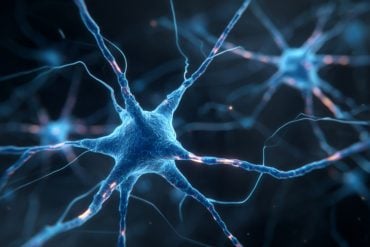Summary: Couples who sleep next to one another have increased REM sleep and less disrupted sleep than couples who slept individually.
Source: Frontiers
In many countries, sharing a bed with a partner is common practice. Yet, research investigating the relationship between bed sharing and sleep quality is both scarce and contradictory. Most studies have compared co-sleep to individual sleep in couples by only measuring body movements. However, Dr. Henning Johannes Drews of the Center for Integrative Psychiatry (ZIP), Germany and colleagues overcame these limitations by also assessing sleep architecture in couples that shared a bed.
Researchers conducted the study among 12 young, healthy, heterosexual couples who spent four nights in the sleep laboratory. They measured sleep parameters both in the presence and absence of the partner using dual simultaneous polysomnography, which is a “very exact, detailed and comprehensive method to capture sleep on many levels — from brain waves to movements, respiration, muscle tension, movements, heart activity” says Dr. Drews. Additionally, the participants completed questionnaires designed to measure relationship characteristics (e.g., relationship duration, degree of passionate love, relationship depth, etc.)
The results showed that rapid-eye movement (REM) sleep is both increased and less disrupted in couples sleeping together compared to when they slept individually. This finding is particularly relevant because REM sleep, which is associated with vivid dreams, has been linked to emotion regulation, memory consolidation, social interactions and creative problem solving.
The team also found that couples synchronize their sleep patterns when sleeping together. This synchronization, which is not linked to the fact that partners disturb each other during the night, is positively associated with relationship depth. In order words, the higher participants rated the significance of their relationship to their life, the stronger the synchronization with their partner.
The researchers propose a positive feedback loop in which sleeping together enhances and stabilizes REM sleep, which in turns improves our social interactions and reduces emotional stress. Although researchers did not specifically measure these possible effects, Dr. Drews says that “since these are well known effects of REM sleep, it is very likely that they would be observed if testing for them.”

Interestingly, researchers found an increased limb movement in couples who share the bed. However, these movements do not disrupt sleep architecture, which remains unaltered. Dr. Drew states that “one could say that while your body is a bit unrulier when sleeping with somebody, your brain is not.”
Although results are promising, many questions remain to be answered. “The first thing that is important to be assessed in the future is whether the partner-effects we found (promoted REM sleep during co-sleep) are also present in a more diverse sample (e.g., elderly, or if one partner suffers from a disease)” says Dr. Drew.
Despite the small sample size and the explorative nature of some of the analyses, this research furthers our understanding of sleep in couples and its potential implication for mental health. Dr. Drews adds that “sleeping with a partner might actually give you an extra boost regarding your mental health, your memory, and creative problem-solving skills.”
About this neuroscience research article
Source:
Frontiers
Media Contacts:
Henning Johannes Drews – Frontiers
Image Source:
The image is in the public domain.
Original Research: Open access
“Bed-Sharing in Couples Is Associated With Increased and Stabilized REM Sleep and Sleep-Stage Synchronization”. by Henning Johannes Drews, et al.
Frontiers in Psychiatry doi:10.3389/fpsyt.2020.00583
Abstract
Bed-Sharing in Couples Is Associated With Increased and Stabilized REM Sleep and Sleep-Stage Synchronization
Background/Objectives: Sharing the bed with a partner is common among adults and impacts sleep quality with potential implications for mental health. However, hitherto findings are contradictory and particularly polysomnographic data on co-sleeping couples are extremely rare. The present study aimed to investigate the effects of a bed partner’s presence on individual and dyadic sleep neurophysiology.
Methods: Young healthy heterosexual couples underwent sleep-lab-based polysomnography of two sleeping arrangements: individual sleep and co-sleep. Individual and dyadic sleep parameters (i.e., synchronization of sleep stages) were collected. The latter were assessed using cross-recurrence quantification analysis. Additionally, subjective sleep quality, relationship characteristics, and chronotype were monitored. Data were analyzed comparing co-sleep vs. individual sleep. Interaction effects of the sleeping arrangement with gender, chronotype, or relationship characteristics were moreover tested.
Results: As compared to sleeping individually, co-sleeping was associated with about 10% more REM sleep, less fragmented REM sleep (p = 0.008), longer undisturbed REM fragments (p = 0.0006), and more limb movements (p = 0.007). None of the other sleep stages was significantly altered. Social support interacted with sleeping arrangement in a way that individuals with suboptimal social support showed the biggest impact of the sleeping arrangement on REM sleep. Sleep architectures were more synchronized between partners during co-sleep (p = 0.005) even if wake phases were excluded (p = 0.022). Moreover, sleep architectures are significantly coupled across a lag of ± 5min. Depth of relationship represented an additional significant main effect regarding synchronization, reflecting a positive association between the two. Neither REM sleep nor synchronization was influenced by gender, chronotype, or other relationship characteristics.
Conclusion: Depending on the sleeping arrangement, couple’s sleep architecture and synchronization show alterations that are modified by relationship characteristics. We discuss that these alterations could be part of a self-enhancing feedback loop of REM sleep and sociality and a mechanism through which sociality prevents mental illness.






